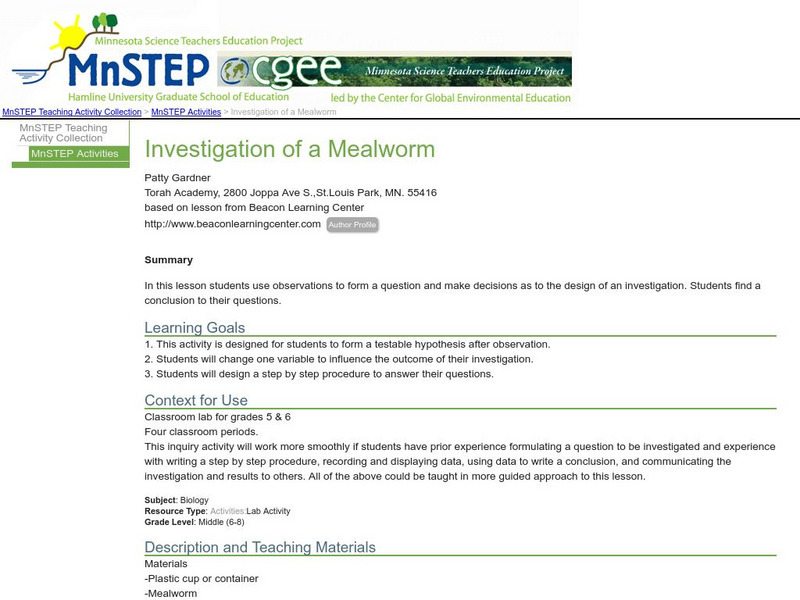Curated OER
Cycles and Starting Mealworms
Here is a fascinating lesson about the life cycles of plants and animals, and other cycles found in nature. Learners explore the cycle of the moon, the tides, and other sequences of events in every day life. The big activity is the...
Curated OER
Mealworms
Crawl into the world of the darkling beetle with this scientific investigation. Watch as the insects move through the larval, pupal, and adult stages of life, recording observations along the way. Discuss the necessities of life as young...
Curated OER
Animal Life Cycle
Young scholars conduct hands-on experiments. For this life cycle lesson, students are able to observe a variety of animals as they travel through their life cycle (brine shrimp, mealworms, frog eggs and chicken eggs). Young scholars...
Curated OER
Who's Been Eating the Oatmeal?
This instructional activity involves students observing the life cycle of a mealworm (beetle) from egg, larva, pupa and adult stages. Student groups receive a plastic container with fresh oatmeal and two to three mealworms. They fill out...
Curated OER
Observing Complete Metamorphosis
Sixth graders read about metamorphosis. They observe the metamorphosis of mealworms and set up the tables using Word processing to record their observations as the mealworms went through the stages of metamorphosis.
Curated OER
Animals: Worms
Young scholars research the physical characteristics of mealworms and tubefex. In this worm lesson, students explore worms using a microscope. Young scholars search their environment for worms.
Curated OER
Butterfly Adventure
Students in second grade are paired with fifth grade computer research buddies. They observe the characteristics of caterpillars, and identify the four stages of the caterpillar to butterfly life cycle. They graph the number of...
Curated OER
Are You Aware?
Bring the five senses to life with a fun science experiment! Kindergartners and first graders read an explanation of the five senses, then identify which items Sophia can sense if she is blindfolded. A science explanation at the bottom...
Curated OER
Environment: Mealworm Observations
Young scholars observe plant and animal growth and participate in class discussions about the subjects. They also record their observations in a log. Using observation and the scientific method, they describe the characteristics of...
Curated OER
Paint's Family Tree
Students sort and classify the genetic traits of horses. In this heredity and genetics instructional activity, students read dialogue in a skit in which specific physical traits of several horses are described and a horse family tree is...
Curated OER
Animal Activities: Teacher's Pets
Students watch meal worms turn into beetles in the classroom.
Curated OER
Take A Meal Worm To Lunch
Seventh graders, using a magnifying glass, observe mealworms in a cup.
Curated OER
Can You Beat Jet Lag?
Middle schoolers examine the health condition of jet lag. Using mealworms, they test the effect of light on the development of them into adults. They answer discussion questions and examine the relationship of age and one's activity...
Curated OER
Magnificent Metamorphosis
Students discover stages in metamorphosis through up close and real encounters with video, hands-on investigative and interactive activities using mealworms.
Curated OER
Peanut Butter Broccoli
Fifth graders explore food production by viewing DNA presentations. In this genetic engineering lesson plan, 5th graders discuss the foods they typically eat at home and how many common foods are engineered in a way that can produce a...
Curated OER
Hey, Look Me Over!
Students make observations about mealworms using hand lenses, rulers, and cotton swabs. Students complete their own mealworm observation chart, then they share their observations with the class. This is one station out of five in an...
Curated OER
Invertebrate Diversity
Comparative anatomy prevails in the lesson exploring diversity among invertebrates. Biologists examine physical characteristics of an earthworm from phylum annelida and a meal worm from phylum insecta. They also inspect a cricket and a...
Curated OER
Life Comes in Cycles
Kids are fascinated by chickens and their eggs. Here is a learning exercise has young learners take a look at the four stages in a chicken's life cycle. They have four cycles to organize: egg, chick, young bird, and adult. They have to...
Curated OER
Invertebrate Diversity
Students observe different animals with bilateral symmetry. In this biology lesson, students compare how these animals move. They discuss the evolutionary history of observed animals.
Curated OER
How to Use Classroom Animals to Spark Life Science Inquiry
Use low maintenance classroom pets to get your students engaged in life science inquiry investigations.
Curated OER
Getting to Know You: Meal Worms
Students recognize differences between themselves and other people, and accept their uniqueness as a positive gift, by studying meal worms.
Curated OER
What Does It Eat?
Students, working in research teams, investigate the eating habits of crickets. They collect and record data and compare their methods and results with other groups by making tables or graphs. They sumarize their findings with posters or...
Science Education Resource Center at Carleton College
Serc: Investigation of a Mealworm
A lab activity where students make observations about mealworms to form questions and decide what direction their investigation will take. While studying mealworms, students will choose a variable to change to observe changes to the...






















